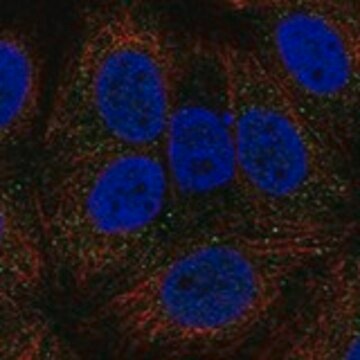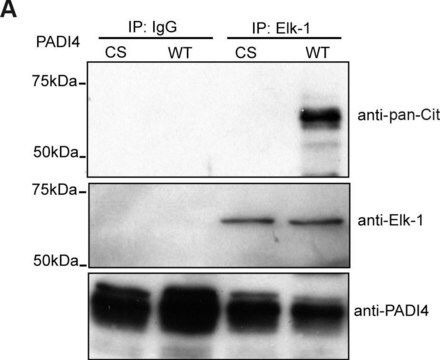MABE1121
Anti-Ago1 Antibody, clone 4B8
clone 4B8, from rat
Sinónimos:
Protein argonaute-1, Argonaute1, hAgo1, Argonaute RISC catalytic component 1, Eukaryotic translation initiation factor 2C 1, eIF-2C 1, eIF2C 1, Putative RNA-binding protein Q99, Ago1
About This Item
Productos recomendados
biological source
rat
Quality Level
antibody form
purified immunoglobulin
antibody product type
primary antibodies
clone
4B8, monoclonal
species reactivity
human
technique(s)
western blot: suitable
isotype
IgG2aκ
NCBI accession no.
UniProt accession no.
shipped in
wet ice
target post-translational modification
unmodified
Gene Information
human ... AGO1(26523)
General description
Specificity
Immunogen
Application
Epigenetics & Nuclear Function
RNA Metabolism & Binding Proteins
Western Blotting Analysis: A representative lot detected Ago1-containing messenager ribonucleoprotein (mRNP) complexes primarily in the low density fractions of sucrose gradient-fractionated HEK293 lysate (Höck, J., et al. (2007). EMBO Rep. 8(11):1052-1060).
Immunoprecipitation Analysis: Representative lots immunoprecipitated FLAG-tagged Ago1, but not FLAG-tagged Ago2, Ago3, or Ago4 (Ender, C., et al. (2008). Mol. Cell. 32(4):519-528; Beitzinger, M., et al. (2007). RNA Biol. 4(2):76-84).
RNA Binding Protein Immunoprecipitation (RIP): Representative lots co-immunoprecipitated Ago1-associated RNAs, including mRNAs, miRNAs, and snoRNAs from human cell lysates (Li, Z., et al. (2009). J. Virol. 83(24):12751-12758; Ender, C., et al. (2008). Mol. Cell. 32(4):519-528; Beitzinger, M., et al. (2007). RNA Biol. 4(2):76-84).
Quality
Western Blotting Analysis: 1.0 µg/mL of this antibody detected Ago1 in 10 µg of HeLa cell lysate.
Target description
Physical form
Storage and Stability
Other Notes
Disclaimer
¿No encuentra el producto adecuado?
Pruebe nuestro Herramienta de selección de productos.
Storage Class
12 - Non Combustible Liquids
wgk_germany
WGK 1
flash_point_f
Not applicable
flash_point_c
Not applicable
Certificados de análisis (COA)
Busque Certificados de análisis (COA) introduciendo el número de lote del producto. Los números de lote se encuentran en la etiqueta del producto después de las palabras «Lot» o «Batch»
¿Ya tiene este producto?
Encuentre la documentación para los productos que ha comprado recientemente en la Biblioteca de documentos.
Nuestro equipo de científicos tiene experiencia en todas las áreas de investigación: Ciencias de la vida, Ciencia de los materiales, Síntesis química, Cromatografía, Analítica y muchas otras.
Póngase en contacto con el Servicio técnico








